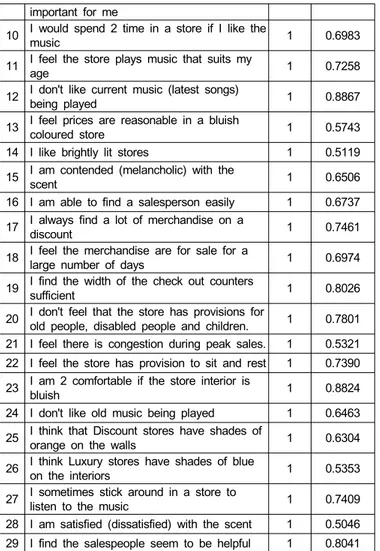Abstract
This research paper has been attempted to inventory the at- mospheric factors, contributing to better sales. Exploratory study was undertaken to identify various signs of store atmospherics variables that influence the buying behaviour of buyers.
Thirty-four variables identified from this study were used to cre- ate a structured questionnaire. This questionnaire was then ad- ministered among shoppers in NCR Delhi using non-probability convenience sampling. To determine the atmospheric factors, Principal Component Analysis (PCA) along with Varimax Rotation was attempted. Using principal component factor analy- sis on the data collected, nine factors were identified to have impact on the store atmospheric. These were Querulous, Music, Sensitive, Budget Seeker, Sensuous, Light, Idler, Space seeker and Comfort Seeker. Contrary to the various earlier studies where music, space seeker and comfort seeker were considered to be most significant factors, light and querulous have emerged out to be the major factor that influences the store atmospheric.
This study shows that customers are sensitive, space seekers and sensuous. Constituents of these factors reveal distinct patterns. This research may be used as guidelines for develop- ment and management of shopping malls in emerging countries.
Retail marketers in India can take this cue in designing their strategies to attract consumers.
Keywords: Retail, Shopping malls, Store atmospherics, Factor analysis, Consumer behavior, India.
JEL Classification Codes: M30, M31, M39
* First author, Professor of Marketing, Indian Institute of Management (IIM) [Old Dhamtari Road, Sejbahar, Raipur-492015, Chhattisgarh, India. E-mail: dr.sanjeev.prashar@gmail.com]
** Consultant, FDDI. [A - 10 / A, Sector 24, Gautam Budh Nagar, Noida, Uttar Pradesh 201301, India. E-mail: pran.verma@gmail.com]
*** Corresponding author, FPM Scholar. Indian Institute of Management (IIM) [Old Dhamtari Road, Sejbahar, Raipur-492015, Chhattisgarh, India. E-mail: chandanparsad@gmail.com]
**** FPM Scholar, Indian Institute of Management (IIM) [Old Dhamtari Road, Sejbahar,Raipur-492015, Chhattisgarh, India. E-mail: tsaivijay@gmail.com]
1. Introduction
Retail atmospherics is the combination of all the tangible and intangible elements of a retail a-outlet, controlled and managed by the owner-managers for enriched shopping behaviour of the con- sumer that is favorable to the seller (Eroglu & Machleit, 1989). As defined by Kotler (1973), the concept of atmospherics is defined as "The effort invested to create a desirable buying environment in order to induce specific emotional responses in consumers and ultimately, increase their purchase probability."Store Atmospherics is in what manner the shoppers perceive the store ambiance, which comprises of lighting, store aroma, layout, packaging of product, and music etc. The importance of store atmospherics changes with merchandise category. Generally it is presumed that for fruit, vegetable and food categories, atmospherics doesn’t affect the consumer whereas for consumer durables, apparels, and life- style it does play a vital role (Gandhi et al., 2010). There seems to be some inherent trustworthiness to the stores (Sinha &
Banerjee, 2004). Tangible backed by intangible of the product is important in these categories. In addition to that lighting, store layout, merchandise assortment, background music, class of traf- fic and odor/ store aroma also has an impact on consumer buy- ing behaviour (Chebat & Dube, 2000).
The stores are perceived by consumers in multi-dimensional ways and these aspects vary significantly across the various kinds of store (Sinha & Banerjee, 2004). In light of the fact that so many similar retail stores are coming up in the country, am- bience has become the mainstay of newly opened stores.
Where ambiance shall essentially include lighting, music, store scaping, props and others. An exciting store environment facili- tated the motivational factor(s) for purchase. Motivational factors shall be directed and focused when the buying is compulsory then the ambiance has no meaning. If the buying is undirected and focused it shall be recreational and ambiance has a pos- itive effect (Kaltcheva & Weitz, 2006).
Store atmospherics is central to any retail outlet. A lot of ex- perimental studies have been conducted on individual parame- ters like light, sound, odor and colour etc to study their impact on consumer shopping behaviour. The focus of this paper was to explore the effect of various atmospheric parameters as a whole on the buying behaviour of customers towards a luxury or economy store. A review of literature pertinent to this study Print ISSN: 2288-4637 / Online ISSN 2288-4645
doi: 10.13106/jafeb.2015.vol2.no3.5.
Factors Defining Store Atmospherics in Convenience Stores: An Analytical Study of Delhi Malls in India
1)
